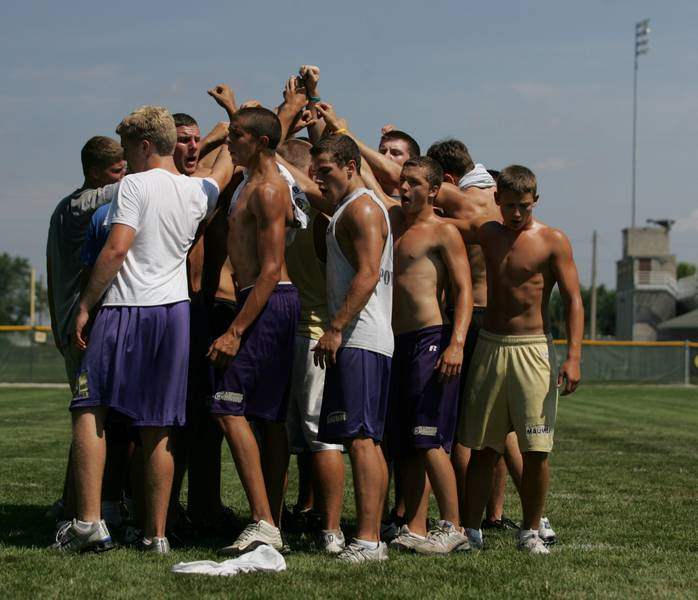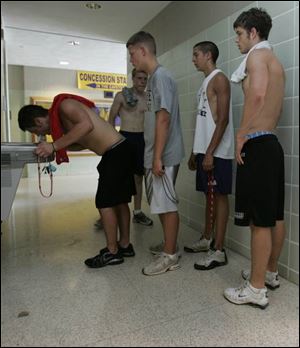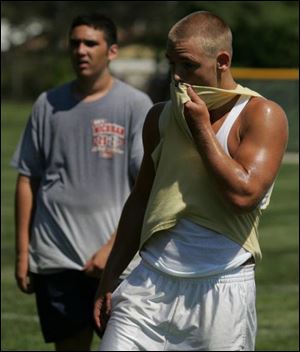
Handling the heat: Danger lurks during summer practice
7/26/2006
Maumee football players huddle up after a 30-minute workout. Strenuous activity, such as football conditioning drills, and summer heat can be a dangerous combination.

Maumee football players huddle up after a 30-minute workout. Strenuous activity, such as football conditioning drills, and summer heat can be a dangerous combination.
As high school athletes start preparing for their upcoming seasons, they must deal with summer heat.
They may be dreaming of championships, but a hidden danger sparked by the combination of extreme heat and strenuous exertion can put an abrupt halt to those dreams, and even lives.
Two of the most threatening illnesses are heat exhaustion and heatstroke. According to the Centers for Disease Control and Prevention from 1979-2002, 4,780 people died of heat-related complications in the United States. The exact number who sought treatment for heat-related problems was not recorded, but it is estimated in the thousands each year.

Maumee's Andrew Steinwand hits the drinking fountain while some of his teammates wait their turn. Today's coaches know proper hydration is important.
"We focus on it very hard as health-care professionals," said Dr. Kris Brickman, director of the emergency department at University Medical Center. "You can't focus on it enough this time of year. Organ shutdown happens very quickly with heat-related illness."
Last Wednesday, a 16-year-old football player from Kentucky collapsed after a 90-minute practice in 88 degree heat with 71 percent humidity. Ryan Owens died about an hour later. An autopsy proved inconclusive, but the local coroner said, "He was a healthy young man."
In August of 2001, former Ohio State University lineman Korey Stringer died at the age of 27 due to complications from heatstroke after collapsing during practice at the Minnesota Vikings' training camp.
Heat exhaustion is the most common heat-related illness and involves dysfunction of temperature control during strenuous exercise which leads to dehydration. Heat exhaustion may lead to heatstroke, which is extreme hyperthermia and can cause organ damage and even death.
Dr. Brickman, who is the team physician for all sports teams at St. John's Jesuit, said the key to preventing heat-related illness is hydration and keeping athletes cooled down.

Maumee's Kyle Bridge wipes sweat from his face during football conditioning.
"Taking in fluids often and frequent breaks are crucial," he said. "Any way they can cool down."
Dr. Brickman said in his 20 years of practicing in the area he did not know of any cases where a high school athlete had died from heatstroke.
"But I hope it never gets taken for granted," he said.
Dr. Brickman estimated that about five to 10 young athletes get sick enough to be taken to area emergency rooms each summer during preseason training. And that might not be sufficient.
"If they are so sick that the brain shuts down, that affects all the organs," Dr. Brickman said. "The effort to prevent a death is based on acting appropriately on the spot."
John Boles, Maumee's football coach for nine years, said the essential element to prevent heat illness is "to give water to the kids as often as the kids want it."
Boles, who has been involved in high school football for 29 years, said during his two-a-day practices, he tells his players to drink plenty of liquids when they go home. He said a player may lose five to 10 pounds a day.
"We stress fluids all the time," he said. "There are no limits to the amount."
Bruce Peterson, who has coached the girls soccer team at St. Ursula Academy for seven years, said he has never had a player collapse due to problems with the heat. But Peterson said he constantly watches his players to see any physical manifestations of heat exhaustion.
"We see if they feel woozy or just look uncomfortable," he said. "We don't let them go 15 minutes without a break for water and a spray down with water."
Peterson makes his players consume sports drinks to replenish lost sodium, electrolytes and other essentials.
"We also tell them to load up on carbs," Peterson said. "We tell them to eat peanut butter, bagels, pasta and those kinds of things."
Peterson said he weighs his players before and after practice during the preseason.
"If they have more than four percent loss in body weight, they can't get back on the field," he said.
Perrysburg athletic director Ray Pohlman said he instructs his coaches to build scheduled water breaks into every practice.
"And any time they want to take a water break, they can go," said Pohlman, who also is an assistant football coach. "We want the kids to be very comfortable to get water when they want it."
Pohlman, who has been involved in coaching for 29 years, said that philosophy has changed drastically.
"In days past, you would not drink until you were told to," he said. "Back in the day, they'd hand salt tablets to you and tell you you couldn't drink anything. We've come a long way."
He said all of his coaches are sent to a state-certified first aid course every three years. Pohlman said his staff educates kids to avoid caffeinated beverages and dress properly.
In the case of football, Dr. Brickman said players should be encouraged to remove their helmets frequently.
"The helmet serves as an oven for the brain," he said. "They need to remove the helmet and let it evaporate off."
Pohlman said proper hydration was at the top of his list when he ran the regional all-star football clinic in mid-July. About 90 recently graduated seniors participated in the week-long event.
"It was humid," Pohlman said. "We had water out there running full blast."
At St. John's, Dr. Brickman said players are given breaks every 30 minutes. He said "water troughs" are available constantly for players to run their heads under.
"The difficult thing about it is that 17-year-olds think they are invincible," Dr. Brickman said. "And there are still old-school coaches who still do the same things that they were forced to do as players."
Dr. Brickman said if the temperature is greater than 90 degrees, practice sessions should last no more than 30 minutes.
Boles said he has never had a player go down because of heat. But when he played at Bowling Green State University, he said a few players had to be taken to the hospital due to heat related problems.
"It's scary," he said.
Contact Mark Monroe at:
mmonroe@theblade.com
or 419-724-6110.